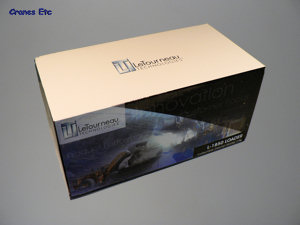 | | The box. | 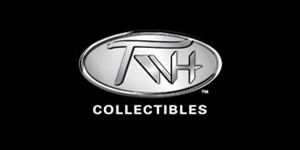 | 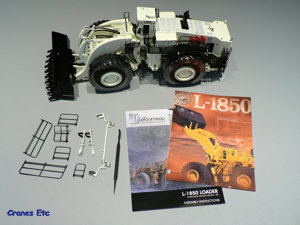 | | The parts out of the box. | 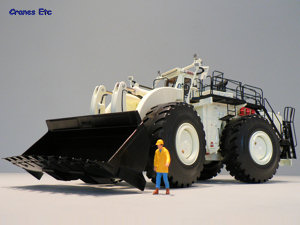 | | A big loader - no messing. | 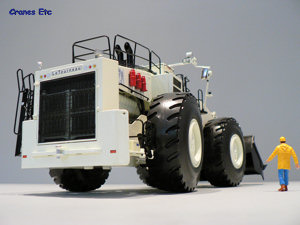 | | The massive tyres dominate. | 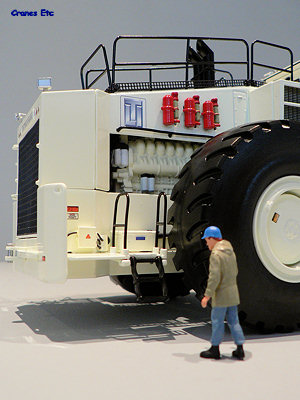 | | The rear access steps to the engine fold down. | 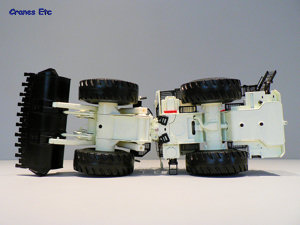 | | Underside view. | 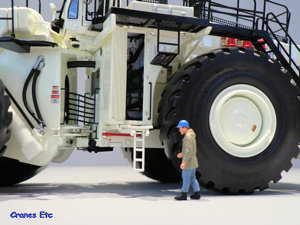 | | With the platform extended and ladder lowered, the equipment can be accessed. The steering locking bar (coloured red) is situated below the cabinet. | 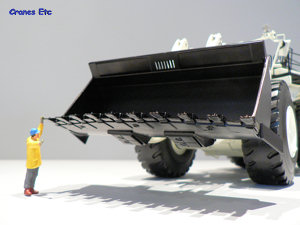 | | Imposing bucket. | 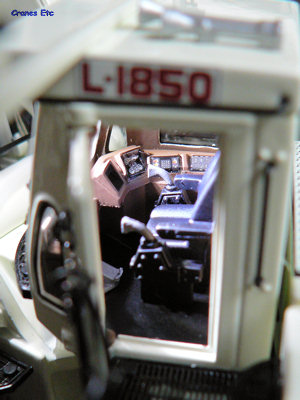 | | Detailed cab interior. | 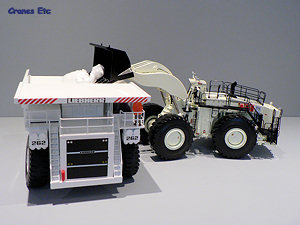 | | The LeTourneau reaches up to load the massive Liebherr with ease. |
| LeTourneau Technologies is based in Texas and has had a long history in earthmoving equipment stretching from when the company was founded by R G LeTourneau in the 1920s.
The most popular rubber-tyred front loader made by LeTourneau is the L-1850. It is designed for use in mining and quarrying operations where it can be efficiently matched with trucks in the 190-320 ton range. The machine is very large with a bucket capacity of 33yd³ (25m³), and it weighs over 500,000lbs (230 tonnes). The fuel tank alone holds over 1000 US gallons (4000 litres).
Packaging
The model comes in a presentation picture sleeve box, and is securely packed within a pair of expanded polystyrene trays. There were no defects or missing parts on the review model.
Two small brochures are supplied. The first is a print of the specifications of the real machine. The second is a simple but exceptionally clear set of assembly instructions which also includes an inventory of parts.
The only assembly required is for some hand railing and lighting holders and this is easily and quickly accomplished, although the lighting parts are loose fitting some collectors will be tempted to secure them with a light glue or putty.
A plastic pointer tool is provided to ease the opening of doors on the model.
Detail
The L-1850 is an impressive size, and initial impressions of the detail are very good.
Underneath, the model has a fairly simple level of detail on the axles with various rivets being seen in the castings. The tyres are of large well moulded rubber with a deep tread and a realistic looking bulge in the tyre wall. They are mounted on metal hubs which have tiny caution notices printed on.
At the front, the bucket is a large heavy piece with excellent teeth which are actually quite sharp. It also has a pair of lifting eyes and the top has a serrated window to enable the operator to see better what is in front of the machine. The linkage arms are heavily built with fine pipe work and hose detailing. The main lift cylinders have excellent hydraulic hosing leading to realistic connectors. The cylinder jackets are plastic however, and this slightly undermines the overall feel of quality. Just in front of the cab are some first class mesh walkways and hand rails, and a lighting stalk on each side containing silvered lamps.
The operator's cab is a fine piece of modelling. Air horns, windscreen wipers, safety chains and fine gauge grab rails provide the detail on the outside and the inside is fully detailed with controls and pedals. Across the top of the cab runs a lighting bar which holds lamps complete with electric wiring and nicely silvered convex mirrors.
Below the cab is the pivot area and this has a number of very small warning notices together with hoses that run to the front from the engine compartment, which itself has some finely detailed equipment even though it is in an obscure location. On the right side outside the cab is an excellent mesh platform with an access ladder downwards, and air conditioning equipment. A step leads up to the roof of the engine compartment which has a mesh surface covering. Two chunky metal exhaust stacks protrude. Fire suppressing equipment is mounted on each side of the engine housing, and is nicely done. The engine block is detailed and appears to be plastic.
On the left side another excellent mesh walkway extends all the way to some access stairs at the rear. Below the cab on this side is an equipment cupboard which includes a mass of electrical wiring and is an impressive detail. A steering locking bar is also included, although it is not functional. At the rear, the huge radiator block is protected by an extremely fine mesh screen. Behind the screen there are very detailed radiator arrays. Lights and a towing hitch complete the detail.
Features
The rear axle is 'floating' so the front wheels can take a tilt of around 8mm (1/3 inch) with the rear wheels still grounded. The pivoted steering works well providing an offset of around 35° from a straight position.
Raising the bucket was a little stiff on the review model and it takes some effort to achieve a 'dump' position. However the benefit of this is there is no danger of any cylinder bleed and so the bucket can be positioned at any height and will hold the pose.
The cab door opens, as does the equipment cabinet below it. This cabinet also features a pull-out platform and access ladder.
At the rear, the main access stair can be lowered for access, and a smaller set of access steps folds down on the opposite side. The radiator cover opens, and the two radiator banks swing out.
Quality
TWH have produced a high quality model which certainly looks good on display. There are some plastic parts, although the overall feel of the model is very good. Paintwork and graphics are also very good.
Price
This model is good value for its size and quality.
Overall
The LeTourneau L-1850 is an impressive looking model, and a welcome addition to the large mining model sector. It has been executed very well and marks a step forward in mass produced large mining shovels, with perhaps the plastic cylinder jackets being the only real criticism. Overall this is a must-have model for the collector of mining equipment.
Footnotes
The model first appeared at dealers in August 2008. The run of the model is 2324 units. The L-1850 was produced in the following versions:
Yellow, old logo, available to collectors, run of 1100
White, old logo, available to collectors, run of 649
Yellow, new logo, for LeTourneau
White, new logo, for LeTourneau
A version with a 55yd³ bucket was introduced in 2009 and is reviewed here.
|
| |
| 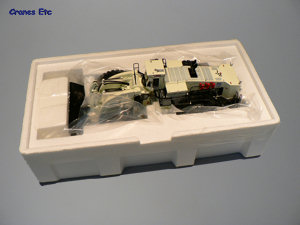 | | The L-1850 nestles in the tray. | 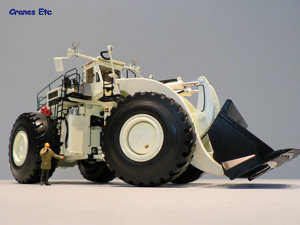 | | Towering dimensions of the L-1850. | 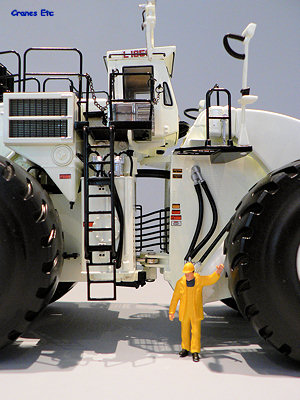 | | Access ladder to the cab. | 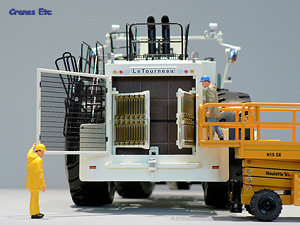 | | Getting access to the radiator banks using a Haulotte H15 SX scissor lift. | 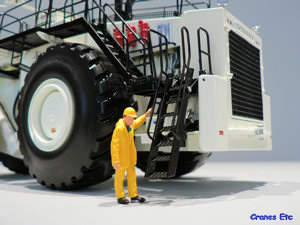 | | The main stairway is lowered. | 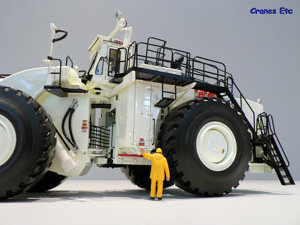 | | The equipment cabinet has a pull-out platform and ladder. | 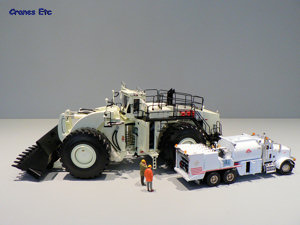 | | Getting some service from the Elliot Lube truck. | 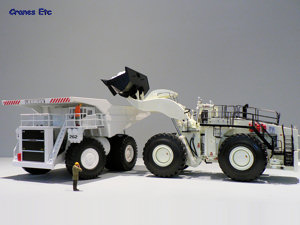 | | Loading a Liebherr T262. | 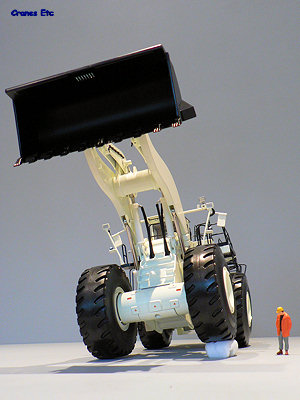 | | The floating rear axle allows articulation for rough surfaces. |
|

